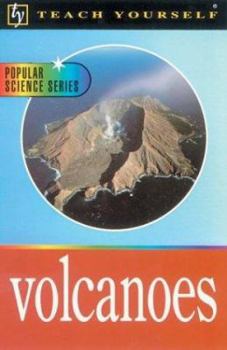Teach Yourself Volcanoes
This title describes the processes involved in volcanic eruptions and building volcanoes. It describes the interactions between volcanoes and the environment and climate and the hazards posed by... This description may be from another edition of this product.
Format:Paperback
Language:English
ISBN:0071384464
ISBN13:9780071384469
Release Date:January 2002
Publisher:McGraw-Hill Companies
Length:192 Pages
Weight:0.66 lbs.
Dimensions:0.7" x 5.2" x 7.8"
Customer Reviews
2 ratings
One of the best geology books I've read
Published by Thriftbooks.com User , 19 years ago
This is a very cool book on volcanoes. It's well written, informative, and very interesting. I agree with the other comment here that it's easily accessible by the layman and explains everything in language you can understand. The explanations are clear and concise. The book is notable for several other reasons. Besides the usual chapters on basic vulcanology and geology, where the types of volcanoes, structure of volcanoes, and so on is discussed, much of the book is devoted to the dangers and hazards of volcanoes and how to deal with them. These chapters cover the history of the most famous eruptions, the destruction wreaked, and the more serious climatological changes, which I read with a sort of morbid fascination. In one of these chapters, on volcanoes and climate, the author discusses the theory that "super volcano" eruptions are thought to be responsible for major extinctions around the globe just as in the case of the Alvarez meteor extinction of the dinosaurs at the end of the Cretaceous. I was already familiar with some of these events from previous reading, such as Krakatoa, Pompeii and Herculaneum, but more is known now, but eruptions such as Toba and Tambora were were much larger even than these. The Tambora eruption of 1815 spewed 50 cubic kilometers of ash into the air and killed 60,000 people on Indonesia, even more than were killed 60 years later by the the tsunami in 1883 from Krakatoa. That year came to be known as the "year without a summer" and caused a very cold winter that year and crop failures around the world which killed tens of thousands of more people. The dangers of pyroclastic flows and of lahars get special attention and are discussed in detail. "Lahar" is an Indonesion word for fast moving flows of ash mixed with water that act like concrete, trapping people and animals and burying towns. The author provides a table of the biggest eruptions showing info such as measured or estimated size (with the so-called "VEI number") and total loss of life. The third chapter discusses the destructive effects of volcanoes on climate which I mentioned earlier. One of these was especially noteworthy. About 70,000-80,000 years ago the Toba eruption occurred, the greatest one known since humans evolved. The author says 2000 million tons of carbon dioxide and sulfur dioxide were spewed into the atmosphere. The most conservative estimate of the dimming of sunlight caused by the volcanic aerosols of Toba may have been sufficient to dim sunlight to 1/10th of its normal value. This would have been enough to arrest or kill much of the trees and vegetation over much of the earth's surface. You may be familiar with the "Eve hypothesis" in human evolution, which is the idea that all modern humans can trace their ancestry back to a single individual as a result of mitochondrial DNA analysis. It's now thought that the Toba eruption could have been the cause of that, when most of the world's population was wiped out by the Toba eruption
The best volcano book for the layman, bar none
Published by Thriftbooks.com User , 21 years ago
A good many folks have a passing interest in volcanoes, especially when a mountain like Kilauea or St. Helens erupts. Yet, most books on the subject are either very dry and technical, or, equally bad, overly concern themselves with the human details of a particular event, leaving the science of the thing as an abandoned stepchild. This excellent book suffers neither fault.Simply put, if you want to learn the whys and wherefores of this most spectacular natural process, this is your book. The reading style is effortless, and not beyond the comprehension of anyone with a high school background in the sciences. The illustrations and diagrams are carefully chosen to clarify or expand upon points in the text. While reciting the individual and societal effects of volcanic activity, the book does not get bogged down in a welter of minutiae, and holds the reader's interest to the end. The author has made every attempt to bring the text up to the state of the art in terms of scientific advances, and the reader benefits. Such concepts as plate tectonics, hot spots, and the like are well explained. Finally, for readers who live in the Western U.S., or anticipate travelling there, the book explains and illustrates a number of landforms that might elude one's attention, but for reading this fine work. Upon concluding the book, the reader will have an understanding of volcanism, its landforms, and its effects on people superior to anyone, save a full-time geologist. I enthusiastically recommend it to all readers.





